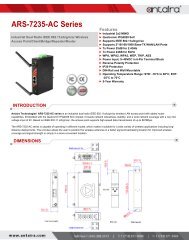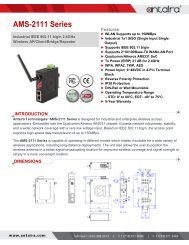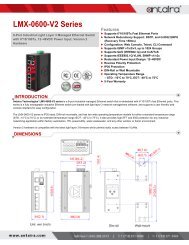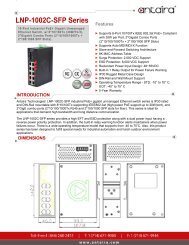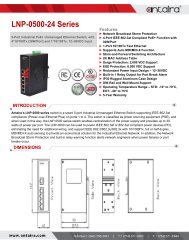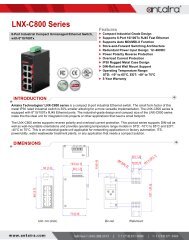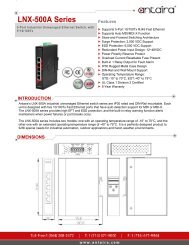- Page 1: Heavy-duty connectors Catalogue 201
- Page 5 and 6: RockStar ® - Heavy Duty Connectors
- Page 7 and 8: Product overview RockStar ® - Heav
- Page 9 and 10: Contents Overview Overview Construc
- Page 11 and 12: Overview Part codes for inserts HDC
- Page 13 and 14: Overview Overview of sizes 2, 5, 7,
- Page 15 and 16: Overview Overview A S4 S4/0 S6/12 S
- Page 17 and 18: Overview A 2028800000 A.9
- Page 19 and 20: Overview Overview of sizes 3, 4, 6,
- Page 21 and 22: Technical data Overview An overview
- Page 23 and 24: Technical data Overview of crimp co
- Page 25 and 26: Technical data Tightening torques a
- Page 27 and 28: Overview Housing IP68 Overview A Th
- Page 29 and 30: Overview Part codes for housings IP
- Page 31 and 32: Overview Part codes for housings IP
- Page 33 and 34: Overview Panel cut-out Housings IP6
- Page 35 and 36: Technical data Influencing factors:
- Page 37: Technical data Overview The deratin
- Page 41 and 42: Technical data IP classes of protec
- Page 43 and 44: Technical data Chemical resistance
- Page 45 and 46: Contents RockStar ® inserts RockSt
- Page 47 and 48: Introduction Consistency One plasti
- Page 49 and 50: HA series - the slim connectors Roc
- Page 51 and 52: HA series - the slim connectors Hou
- Page 53 and 54: HA series - the slim connectors Hou
- Page 55 and 56: HA series - the slim connectors Hou
- Page 57 and 58: HA series - the slim connectors Hou
- Page 59 and 60: HA series - the slim connectors Hou
- Page 61 and 62: HA series - the slim connectors Hou
- Page 63 and 64: HE series - the universal connector
- Page 65 and 66: HE series - the universal connector
- Page 67 and 68: a a HE series - the universal conne
- Page 69 and 70: HE series - the universal connector
- Page 71 and 72: HE series - the universal connector
- Page 73 and 74: HE series - the universal connector
- Page 75 and 76: HE series - the universal connector
- Page 77 and 78: HEE series - high contact density R
- Page 79 and 80: HEE series - high contact density H
- Page 81 and 82: a a HEE series - high contact densi
- Page 83 and 84: HEE series - high contact density H
- Page 85 and 86: HEEE series - high contact density
- Page 87 and 88: HEE series - high contact density H
- Page 89 and 90:
HEE series - high contact density H
- Page 91 and 92:
HD series - the flexible connectors
- Page 93 and 94:
a b HD series - the flexible connec
- Page 95 and 96:
a b HD series - the flexible connec
- Page 97 and 98:
HD series - the flexible connectors
- Page 99 and 100:
HD series - the flexible connectors
- Page 101 and 102:
HD series - the flexible connectors
- Page 103 and 104:
HD series - the flexible connectors
- Page 105 and 106:
HD series - the flexible connectors
- Page 107 and 108:
HD series - the flexible connectors
- Page 109 and 110:
HD series - the flexible connectors
- Page 111 and 112:
HDD series - the compact connectors
- Page 113 and 114:
HDD series - the compact connectors
- Page 115 and 116:
HDD series - the compact connectors
- Page 117 and 118:
HDD series - the compact connectors
- Page 119 and 120:
HDD series - the compact connectors
- Page 121 and 122:
HDD series - the compact connectors
- Page 123 and 124:
HDD series - the compact connectors
- Page 125 and 126:
HVE series - exciting voltage RockS
- Page 127 and 128:
HVE series - exciting voltage Housi
- Page 129 and 130:
HVE series - exciting voltage Housi
- Page 131 and 132:
HVE series - exciting voltage Housi
- Page 133 and 134:
HSB series - the heavy-duty connect
- Page 135 and 136:
HSB series - the heavy-duty connect
- Page 137 and 138:
HSB series - the heavy-duty connect
- Page 139 and 140:
HQ series - the powerful little con
- Page 141 and 142:
HQ series - the powerful little con
- Page 143 and 144:
HQ series - the powerful little con
- Page 145 and 146:
HQ series - the powerful little con
- Page 147 and 148:
HQ series - the powerful little con
- Page 149 and 150:
HQ series - the powerful little con
- Page 151 and 152:
HQ series - the powerful little con
- Page 153 and 154:
MixMate series - the high-capacity
- Page 155 and 156:
MixMate series - the high-capacity
- Page 157 and 158:
MixMate series - the high-capacity
- Page 159 and 160:
MixMate series - the high-capacity
- Page 161 and 162:
MixMate series - the high-capacity
- Page 163 and 164:
MixMate series - the high-capacity
- Page 165 and 166:
MixMate series - the high-capacity
- Page 167 and 168:
MixMate series - the high-capacity
- Page 169 and 170:
MixMate series - the high-capacity
- Page 171 and 172:
MixMate series - the high-capacity
- Page 173 and 174:
MixMate series - the high-capacity
- Page 175 and 176:
MixMate series - the high-capacity
- Page 177 and 178:
Contents RockStar ® ModuPlug modul
- Page 179 and 180:
Introduction Secure The round and r
- Page 181 and 182:
RockStar ® ModuPlug modular system
- Page 183 and 184:
RockStar ® ModuPlug base module Si
- Page 185 and 186:
RockStar ® ModuPlug modules ModuPl
- Page 187 and 188:
ModuPlug ® HDC MHE 6P Technical da
- Page 189 and 190:
ModuPlug ® HDC MHE 8 Technical dat
- Page 191 and 192:
ModuPlug ® HDC MHD 36 Technical da
- Page 193 and 194:
RockStar ® ModuPlug modules ModuPl
- Page 195 and 196:
RockStar ® ModuPlug modular system
- Page 197 and 198:
RockStar ® ModuPlug data inserts C
- Page 199 and 200:
Contents RockStar ® HighPower Rock
- Page 201 and 202:
Introduction Practical and universa
- Page 203 and 204:
RockStar ® HighPower 250 A RockSta
- Page 205 and 206:
RockStar ® HighPower 250 A RockSta
- Page 207 and 208:
RockStar ® HighPower 250 A RockSta
- Page 209 and 210:
RockStar ® HighPower 550 A RockSta
- Page 211 and 212:
RockStar ® HighPower 550 A RockSta
- Page 213 and 214:
RockStar ® HighPower 550 A RockSta
- Page 215 and 216:
RockStar ® Housings IP65 / NEMA Ty
- Page 217 and 218:
Reliable Guaranteed protection agai
- Page 219 and 220:
Plastic housing Size 1 Base Bulkhea
- Page 221 and 222:
Metal housing Size 1 Base Bulkhead
- Page 223 and 224:
Die cast zinc housing (EMC) Size HQ
- Page 225 and 226:
End locking, lower side Size 2 Base
- Page 227 and 228:
End locking, lower side Size 3 Base
- Page 229 and 230:
a a Side locking, lower side Size 4
- Page 231 and 232:
5 a Side locking, upper side Size 4
- Page 233 and 234:
End locking, lower side Size 5 Hood
- Page 235 and 236:
Side locking, lower side Size 6 Bas
- Page 237 and 238:
Side locking, upper side Size 6 Hoo
- Page 239 and 240:
Side locking, upper side Size 7 Hoo
- Page 241 and 242:
Side locking, lower side Size 8 Bas
- Page 243 and 244:
5 End locking, lower side Size 8 Ba
- Page 245 and 246:
Central-locking clamp Size 8 Hood P
- Page 247 and 248:
Side locking, lower side Size 10 Ho
- Page 249 and 250:
Side locking, upper side Size 10 Ho
- Page 251 and 252:
Contents RockStar ® Housings IP68
- Page 253 and 254:
Introduction Practical Laser labell
- Page 255 and 256:
6 RockStar ® Housings IP68 / EMC S
- Page 257 and 258:
6 RockStar ® Housings IP68 / EMC S
- Page 259 and 260:
RockStar ® Housings IP68 / EMC Scr
- Page 261 and 262:
Contents RockStar ® Data Connector
- Page 263 and 264:
b IE-LINE Variant 5 RockStar ® hea
- Page 265 and 266:
IE-LINE Variant 5 RJ45 plug inserts
- Page 267 and 268:
IE-LINE Variant 5 RJ45 flange inser
- Page 269 and 270:
Contents RockStar ® Kits RockStar
- Page 271 and 272:
Introduction RockStar ® Kits Easy
- Page 273 and 274:
Kits with HA inserts, 3 pole 400 V,
- Page 275 and 276:
Kits with HA inserts, 4 pole 400 V,
- Page 277 and 278:
Kits with HE inserts, 6 pole 500 V,
- Page 279 and 280:
Kits with HE inserts, 6-pole, PUSH
- Page 281 and 282:
Kits with HE inserts, 10 pole 500 V
- Page 283 and 284:
Kits with HE inserts, 10-pole, PUSH
- Page 285 and 286:
Kits with HE inserts, 16 pole 500 V
- Page 287 and 288:
Kits with HE inserts, 16-pole, PUSH
- Page 289 and 290:
Kits with HE inserts, 24 pole 500 V
- Page 291 and 292:
Kits with HE inserts, 24-pole, PUSH
- Page 293 and 294:
Kits with HE inserts, 32 pole 500 V
- Page 295 and 296:
Kits with HE inserts, 48 pole 500 V
- Page 297 and 298:
Contents RockStar ® accessories Ro
- Page 299 and 300:
Introduction Secure Solid, machined
- Page 301 and 302:
Crimp contacts Crimp contacts for f
- Page 303 and 304:
Crimp contacts Technical data Mater
- Page 305 and 306:
Fibre optic contacts Instructions f
- Page 307 and 308:
Coding Coding system with guiding f
- Page 309 and 310:
Coding HE coding pin Use the HE cod
- Page 311 and 312:
Shield lever Shield lever for stand
- Page 313 and 314:
Shield lever RockStar ® accessorie
- Page 315 and 316:
Other accessories HDC GRIP PANEL Te
- Page 317 and 318:
D E F Other accessories HDC screw a
- Page 319 and 320:
Other accessories Profile seals Gas
- Page 321 and 322:
Content Tools Tools Tools Cutting J
- Page 323 and 324:
Crimping Crimping tools for other c
- Page 325 and 326:
Crimping MTR 160 Cross-section Code
- Page 327 and 328:
Crimping Crimping tools for HighPow
- Page 329 and 330:
Crimping HTX-HDC/POF POF crimping C
- Page 331 and 332:
Screwdrivers VDE-insulated torque s
- Page 333 and 334:
Screwdrivers Uninsulated screwdrive
- Page 335 and 336:
Screwdrivers Weidmüller wrench set
- Page 337 and 338:
Miscellaneous Removal Tool CM3, HD
- Page 339 and 340:
Inhalt Cable entries Cable entries
- Page 341 and 342:
Introduction You should always obse
- Page 343 and 344:
Standard cable glands - Plastic Cab
- Page 345 and 346:
Standard cable glands - Brass Cable
- Page 347 and 348:
Standard cable glands - Brass Cable
- Page 349 and 350:
EMC cable glands Cable glands - Bra
- Page 351 and 352:
EMC cable glands Cable glands - bra
- Page 353 and 354:
Standard cable glands - Stainless s
- Page 355 and 356:
Accessories - Flat IP washer Flat I
- Page 357 and 358:
Accessories - Flat IP washer Flat I
- Page 359 and 360:
Sealing plugs Sealing plugs - Plast
- Page 361 and 362:
Sealing plugs Sealing plugs - Plast
- Page 363 and 364:
Contents Service and support Servic
- Page 365 and 366:
Service and support Professional ad
- Page 367 and 368:
Service and support Product selecti
- Page 369 and 370:
Contents Index Index Index Index Ty
- Page 371 and 372:
Type Order No. Page Type Order No.
- Page 373 and 374:
Type Order No. Page Type Order No.
- Page 375 and 376:
XIndex / Type 2028800000 X.7
- Page 377 and 378:
Order No. Type Page Order No. Type
- Page 379 and 380:
Order No. Type Page Order No. Type
- Page 381 and 382:
Order No. Type Page 9020400000 PB L
- Page 383 and 384:
Let’s connect. KR Korea Weidmulle
- Page 386:
Weidmüller - Your partner in Indus








